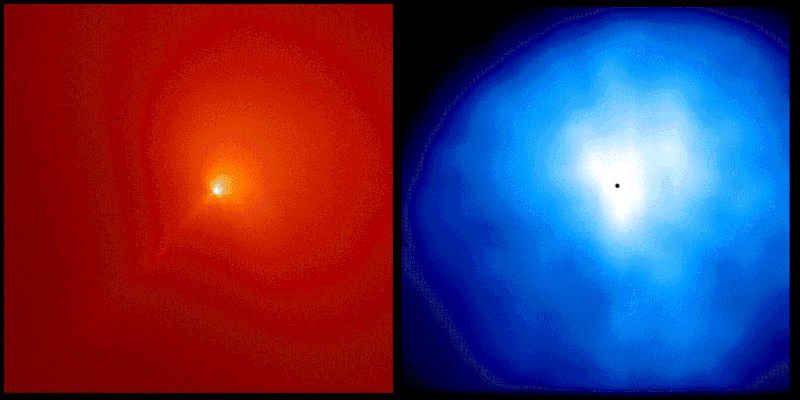File:The Inner Coma of Comet Hyakutake.gif

Original file (1,000 × 500 pixels, file size: 157 KB, MIME type: image/gif)
Captions
Captions
Summary[edit]
| DescriptionThe Inner Coma of Comet Hyakutake.gif |
English: These are two images of the inner coma of Comet Hyakutake made on April 3 and 4, 1996, using the NASA Hubble Space Telescope Wide Field Planetary Camera 2 (WFPC2). The first one, shown in red, was taken through a narrow-band red filter that shows only sunlight scattered by dust particles in the inner coma of the comet. The second one, shown in blue, was taken with an ultraviolet "Woods" filter image that shows the distribution of scattered ultraviolet radiation from hydrogen atoms in the inner coma. The coma is the head or dusty-gas atmosphere of a comet. The square field of view is 14,000 km on a side and the Sun is toward the upper right corner of the image. Hydrogen atoms represent the most abundant gas in the whole coma of the comet. They are produced when solar ultraviolet light breaks up molecules of water, the major constituent of the nucleus of the comet. These images were taken as part of an observing program to study water photochemistry in comets. Measurements of hydrogen (H) and hydroxyl (OH) in the coma (or atmosphere) of Comet Hyakutake were also made using the Goddard High Resolution Spectrograph (GHRS) and the Faint Object Spectrograph (FOS). A self-consistent analysis of all the data shows that the water production rate of the comet was between 7 and 8 tons per second on the April 3 and 4. A theoretical model was used in the analysis, which accounts for the detailed physics and chemistry of the photochemical destruction of the water, the production of the H and OH, and their expansion in the coma (or atmosphere) of the comet. The model matched the velocity measurements of hydrogen atoms made using the high spectral resolution capabilities of the GHRS instrument. The importance of such a detailed model is that it permits the accurate calculation of the production rate of water from observations of H and OH.
The inner yellow region near the center of the red dust image is dominated by the contribution from the dust which shows sunward directed spiral jets toward the upper right, and the thin straight particle trail pointing toward the lower left. The trail was a permanent feature of the comet around the time of its close approach to the earth in late March and early April. Also barely visible just beyond the lower left end of the trail are two of the many condensations which were seen to travel slowly down the tail are are believed to be clumps of material released from the nucleus. The inner white region of the blue image appears to show that the hydrogen atoms like the dust might be preferentially ejected toward the sunward or day side of the nucleus. However, this is not true. The asymmetric ultraviolet radiation pattern is produced by a roughly spherical distribution of hydrogen atoms because they are so efficient at scattering the incoming solar ultraviolet light. The atoms on the sunward side actually shadow the atoms on the tailward or night side of the coma. The same detailed model analysis of the coma which explains the expansion of the hydrogen atoms in the coma also explains the appearance of the image. The team was lead by Michael Combi, The University of Michigan, and included Michael Brown, California Institute of Technology, Paul Feldman, Johns Hopkins University, H. Uwe Keller of the Max-Planck Institute, Lindau, Robert Meier of the Naval Research Laboratory, and William Smyth of Atmospheric and Environmental Research, Inc. |
| Date | |
| Source | http://imgsrc.hubblesite.org/hu/db/images/hs-1998-13-a-full_tif.tif |
| Author | M. Combi (University of Michigan) |
Licensing[edit]
| Public domainPublic domainfalsefalse |
| This file is in the public domain because it was created by NASA and ESA. NASA Hubble material (and ESA Hubble material prior to 2009) is copyright-free and may be freely used as in the public domain without fee, on the condition that only NASA, STScI, and/or ESA is credited as the source of the material. This license does not apply if ESA material created after 2008 or source material from other organizations is in use. The material was created for NASA by Space Telescope Science Institute under Contract NAS5-26555, or for ESA by the Hubble European Space Agency Information Centre. Copyright statement at hubblesite.org or 2008 copyright statement at spacetelescope.org. For material created by the European Space Agency on the spacetelescope.org site since 2009, use the {{ESA-Hubble}} tag. |
File history
Click on a date/time to view the file as it appeared at that time.
| Date/Time | Thumbnail | Dimensions | User | Comment | |
|---|---|---|---|---|---|
| current | 03:57, 19 December 2015 |  | 1,000 × 500 (157 KB) | PlanetUser (talk | contribs) | User created page with UploadWizard |
You cannot overwrite this file.
File usage on Commons
The following page uses this file:
